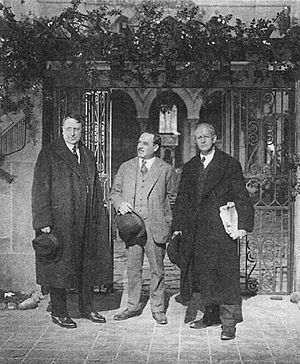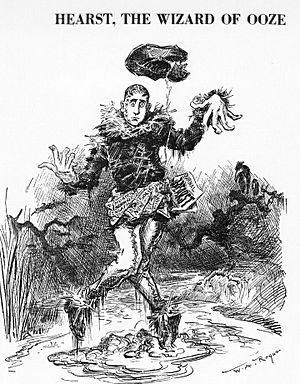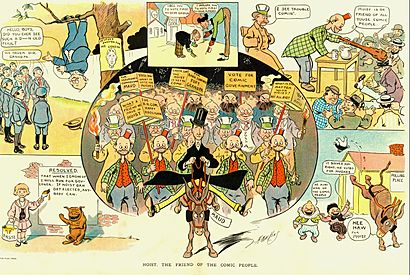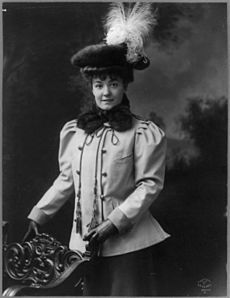William Randolph Hearst facts for kids
Quick facts for kids
William Randolph Hearst
|
|
|---|---|

Hearst, c. 1910
|
|
| Member of the U.S. House of Representatives from New York's 11th district |
|
| In office March 4, 1903 – March 3, 1907 |
|
| Preceded by | William Sulzer (redistricting) |
| Succeeded by | Charles V. Fornes |
| Personal details | |
| Born | April 29, 1863 San Francisco, California, U.S. |
| Died | August 14, 1951 (aged 88) Beverly Hills, California, U.S. |
| Cause of death | Myocardial infarction and stroke |
| Resting place | Cypress Lawn Memorial Park, Colma, California, U.S.A |
| Political party |
|
| Spouse |
Millicent Willson
(m. 1903) |
| Domestic partner | Marion Davies (1917–1951) |
| Children |
|
| Parents |
|
| Alma mater | Harvard University |
| Occupation |
|
| Signature | |
William Randolph Hearst Sr. (/hɜːrst/; April 29, 1863 – August 14, 1951) was a famous American businessman and newspaper publisher. He built the nation's largest newspaper and media company, called Hearst Communications. He was known for his exciting style of journalism, called yellow journalism. This style focused on shocking stories and human interest to grab readers' attention.
Hearst started in the newspaper business in 1887. His rich father, Senator George Hearst, gave him control of The San Francisco Examiner. Later, Hearst moved to New York City and bought the New York Journal. He had a big competition with Joseph Pulitzer's New York World. Hearst sold many papers by using huge headlines and dramatic stories about crime and scandals.
He bought more newspapers, creating a chain of almost 30 papers in major American cities. He also started magazines, building the biggest newspaper and magazine business in the world. Hearst used his papers to share his own views, especially about politics. For example, he wrote sensational stories about events in Cuba, which helped lead to the Spanish–American War in 1898.
Hearst was elected to the U.S. House of Representatives twice as a Democrat. He also tried to become President of the United States in 1904, Mayor of New York City in 1905 and 1909, and Governor of New York in 1906, but he did not win these elections. He often said he supported the working class.
After 1918, Hearst became more conservative. He wanted the U.S. to stay out of European problems. He was against communism and suspicious of international groups like the League of Nations. In the 1930s, his newspapers reached 20 million readers daily. However, he faced money problems during the Great Depression. He had to sell many of his properties, but he managed to keep his newspapers and magazines.
His life inspired the main character, Charles Foster Kane, in the famous film Citizen Kane (1941). His amazing home, Hearst Castle, is now a State Historical Monument in California.
Contents
Early Life and Education
William Randolph Hearst was born in San Francisco, California. His father, George Hearst, was a very rich mining engineer. His mother, Phoebe Apperson Hearst, was from Missouri. George Hearst later became a U.S. Senator.
William's family had roots in Ireland and Scotland. His mother, Phoebe, was a very important woman. She was the first woman Regent of the University of California, Berkeley. She also helped fund libraries and many research trips.
Hearst went to a special school called St. Paul's School. Then he went to Harvard College. While at Harvard, he was part of several clubs. He was known for playing pranks and was eventually asked to leave the university.
Building a Media Empire
After college, Hearst decided to work in newspapers. In 1887, he took over his father's newspaper, the San Francisco Examiner. His father had received it as payment for a gambling debt. Hearst made the paper exciting. He bought the best equipment and hired famous writers like Mark Twain and Jack London.
Hearst called his paper "Monarch of the Dailies." He often wrote about corruption in government and business. Within a few years, his newspaper was the most popular in San Francisco.
The New York Morning Journal
Hearst dreamed of owning many newspapers across the country. In 1895, his mother helped him buy the struggling New York Morning Journal. He hired talented writers and artists. This started a big competition with Joseph Pulitzer's New York World.
Hearst was known for paying his staff well. He gave credit to his writers by putting their names on the front page. He was polite and calm, which made him a popular boss. His approach to journalism was summed up by his motto: "While others Talk, the Journal Acts."
Yellow Journalism and Rivalry
The New York Journal and the New York World used a style of journalism called "yellow journalism." This name came from a popular comic strip called "The Yellow Kid." This style used big headlines, lots of pictures, and dramatic stories. It focused on exciting human-interest stories and crusades for the common people.
Hearst's Journal used this style to gain many readers. Pulitzer's World had to lower its price to compete. The two papers fought fiercely for readers. They spent a lot of money and their sales grew hugely.
Many people criticized yellow journalism for being too sensational. However, Hearst believed it was an honest way to connect with readers. He thought that stories that made people feel emotions would also make them think.
The competition between the two papers ended in 1898. Both papers lost a lot of money covering the Spanish–American War. After this, the Journal started making a profit.
Hearst's Journal supported the Democratic Party. It was the only major paper in the East to support William Jennings Bryan in the 1896 election. The paper strongly criticized the role of money in politics.
The Spanish–American War
The Morning Journals sales went over 1 million copies daily after the U.S. ship Maine sank. This event led to the U.S. entering the Spanish–American War. Some people even called it "The Journals War."
Many stories leading up to the war were full of rumors and sensationalism. The "yellow" papers were seen as the worst offenders. The Journal and other New York papers were very biased. They often printed errors in their reporting. This made people in New York very angry at Spain.
Historians say that Hearst's papers did not directly cause the war. However, they did make public opinion in New York City very strong. People across the country were upset by what Spain was doing in Cuba. This helped Congress decide to declare war.
Hearst himself went to Cuba with his reporters to cover the war. He even brought printing equipment to print a special newspaper there.
Expanding the Empire
Hearst wanted to help his political career. So, he opened newspapers in other cities like Chicago, Los Angeles, and Boston. By the mid-1920s, he owned 28 newspapers across the country. These included the Los Angeles Examiner and the Boston American.
He also started publishing books and magazines. Some of his magazines, like Cosmopolitan and Good Housekeeping, are still popular today.
In 1924, Hearst started the New York Daily Mirror, a tabloid newspaper. He also owned two news services, Universal News and International News Service (INS). He owned a radio station and King Features Syndicate, which still owns rights to many comic characters. He also had a film company, real estate, and land in California and Mexico.
Hearst supported many writers and cartoonists. One of his favorites was George Herriman, who created the comic strip Krazy Kat. Even if it wasn't popular at first, Hearst believed in it. Today, Krazy Kat is considered a classic.
In 1929, Hearst helped sponsor the first round-the-world trip by an airship, the LZ 127 Graf Zeppelin. He insisted the trip start in New Jersey. His sponsorship allowed his photographers and reporters to be on board. One of them, Grace Marguerite Hay Drummond-Hay, became the first woman to travel around the world by air.
Hearst's media empire made a lot of money around 1928. But the Great Depression in the United States caused big financial problems. He was deeply in debt. Most of his properties had to be sold in the late 1930s. He managed to keep his newspapers and magazines. The Hearst Corporation is still a large media company today.
Political Career
Hearst was elected to Congress twice. After that, he lost several elections. He tried to become mayor of New York City in 1905 and 1909. He also ran for governor of New York in 1906. He was a Democrat but also created his own Independence Party.
Hearst was part of the Progressive Movement. He spoke for the working class and criticized the rich. He was elected to Congress from New York in 1902 and 1904. He tried to become the Democratic candidate for president in 1904 but lost.
He was against the British Empire and did not want America to join World War I. He also opposed the League of Nations.
Changing Political Views
In the 1920s, Hearst believed in limited government. He warned against too much federal power. He supported Franklin D. Roosevelt in 1932. However, he later disagreed with Roosevelt's "New Deal" policies. Hearst's newspapers started supporting businesses more and criticized higher taxes.
Hearst broke with Roosevelt in 1935. His papers became a weapon, printing his long, angry editorials. He reached 20 million readers. But many of his working-class readers supported Roosevelt.
Hearst also ordered his editors to print stories about the Ukrainian famine (the Holodomor). These stories were used to criticize Roosevelt's policy of having relations with the Soviet Union.
Support for Nazi Germany
After Adolf Hitler came to power in Germany, Hearst's newspapers gave positive coverage to the Nazis. Hearst visited Berlin in 1934 to interview Hitler. He told Hitler that Americans believed in democracy and were against dictatorships. However, he also told his reporters in Germany to write positive stories about the Nazis. He even fired journalists who refused. Hearst's papers published articles by Nazi leaders like Hermann Göring and Hitler himself.
Personal Life
Family Life
In 1903, Hearst married Millicent Veronica Willson in New York City. She was a 21-year-old chorus girl. They had five sons: George, William Jr., John, Randolph, and David.
Millicent and Hearst separated in the mid-1920s. But they remained married until Hearst died. Millicent became a well-known helper of charities in New York City. She started the Free Milk Fund for the poor in 1921.
California Properties
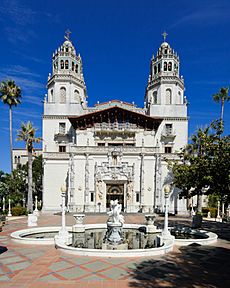
Hearst's father, George Hearst, bought a lot of land in California. In 1865, he bought about 30,000 acres near San Simeon. William Randolph Hearst later inherited this land. He kept buying more land until he owned about 250,000 acres.
In 1940, Hearst sold 158,000 acres of his land to the U.S. government. This land became part of Fort Hunter Liggett, a troop training base for the military.
Hearst also owned land along the Little Sur River. He bought it to protect the redwood forests there. Later, he sold this land to the Boy Scouts of America.
Hearst Castle
Starting in 1919, Hearst began building Hearst Castle on his ranch near San Simeon. He never fully finished it. He filled the mansion with amazing art, antiques, and even entire historic rooms from Europe. He also had a special farm for breeding Arabian horses there.
He also owned property in northern California called Wyntoon. The buildings there were designed by Julia Morgan, who also designed Hearst Castle.
Beverly Hills Mansion
In 1947, Hearst bought a large mansion in Beverly Hills. This house, called the Beverly House, has been featured in movies like The Godfather.
Art Collection
Hearst was famous for his huge collection of art from all over the world and from many centuries. He collected Greek vases, Spanish and Italian furniture, Oriental carpets, and many paintings and statues. He also collected rare books and famous autographs. His guests, including celebrities and politicians, stayed in rooms filled with these treasures.
In 1937, Hearst began selling some of his art collection to help pay off his debts. He sold items like paintings by van Dyke, old church items, Charles Dickens's sideboard, and even George Washington's waistcoat. When Hearst Castle was given to the State of California, it still had enough art and furniture to be a museum.
St Donat's Castle
In 1925, Hearst bought and fixed up St Donat's Castle in Wales. He spent a lot of money buying entire rooms from other castles in Europe and rebuilding them at St. Donat's. For example, the Great Hall was moved from a priory in England. Hearst added 34 marble bathrooms and beautiful gardens.
Hearst and his friend Marion Davies often hosted big parties at the castle. Famous guests like Charlie Chaplin and Winston Churchill visited. After Hearst died, the castle was bought and given to Atlantic College, an international school, which still uses it today.
Interest in Aviation
Hearst was very interested in new flying technologies. He had his first airplane ride in 1910. He also sponsored famous flights, like the round-the-world trip of the Graf Zeppelin.
Financial Challenges
Hearst's strong opinions against Roosevelt and the New Deal, along with strikes, hurt his business. Sales of his papers went down in the mid-1930s. He kept buying expensive art, even though he was losing money.
His financial advisors realized he was millions of dollars in debt. He couldn't pay his loans. His friend Marion Davies even loaned him $1 million by selling her jewelry and stocks. Hearst had to pay rent to live in his own castle.
He avoided officially going bankrupt. But he had to sell thousands of items from his art collection. These sales included tapestries, paintings, furniture, and sculptures. The market for art was not good during the Depression, so he lost a lot of money.
Later Years and Legacy
After the financial problems of the 1930s, the Hearst Company became profitable again during World War II. This was because advertising money increased. Hearst continued to collect art, though on a smaller scale. He also gave many artworks to the Los Angeles County Museum of Art.
In 1947, Hearst left Hearst Castle for medical care. He died in Beverly Hills on August 14, 1951, at age 88. He was buried in the family mausoleum in Colma, California.
His will created two charities, the Hearst Foundation and the William Randolph Hearst Foundation. His sons all followed him into the media business. His son, William Randolph Hearst Jr., became a newspaper reporter and won a Pulitzer Prize.
Criticisms and Influence
Hearst's newspapers were sometimes criticized for their strong opinions. In the 1890s, his papers, especially The Examiner, used strong language against Chinese and Asian people. These ideas continued throughout his career. During World War II, Hearst strongly supported the internment of Japanese-Americans. He used his media power to encourage this.
Critics like Martin Lee and Norman Solomon said that Hearst "often made up sensational stories." They also said he "faked interviews, ran phony pictures and distorted real events."
His use of yellow journalism in the New York Journal was also criticized. People said he used it to stir up public support for U.S. military actions in Cuba and other places in 1898. Critics also said his papers twisted world events and tried to make socialists look bad.
In Popular Culture
Citizen Kane
The famous film Citizen Kane (1941) is partly based on Hearst's life. The movie's main character, Charles Foster Kane, was inspired by Hearst and other powerful men. Hearst was very angry about the film. He tried to stop it from being released, even though he hadn't seen it.
Hearst used his power to pressure movie theaters not to show Citizen Kane. This limited the film's success at the box office. The story of this fight was shown in the documentary The Battle Over Citizen Kane. It was also shown in the HBO movie RKO 281 (1999), where James Cromwell played Hearst. Citizen Kane is often called one of the greatest films ever made.
Other Appearances
Films
- In the TV movie Rough Riders (1997), Hearst (played by George Hamilton) goes to Cuba to cover the Spanish–American War.
- Hearst is mentioned in the Disney movie Newsies (1992). He is shown as a rival to Joseph Pulitzer during a newspaper strike.
- In The Cat's Meow (2001), Hearst (played by Edward Herrmann) is part of a fictional story about a death on his yacht.
- He is played by Matthew Marsh in the 2019 film Mr Jones.
- Charles Dance plays Hearst in the 2020 film Mank.
- He is played by Pat Skipper in the 2022 film Babylon.
Literature
- John Dos Passos's novel The Big Money (1936) includes a short story about Hearst.
- Jack London's novel The Iron Heel (1907) mentions Hearst and predicts his publishing empire will be destroyed.
- In Ayn Rand's novel The Fountainhead (1943), the character Gail Wynand, a newspaper owner, is based on William Randolph Hearst.
- John Steinbeck's novel The Grapes of Wrath (1939) describes a "newspaper fella near the coast" who owns a lot of land, thought to be Hearst.
- In Gore Vidal's historical novels, Hearst is an important character.
Television
- The competition between Hearst and Joseph Pulitzer was shown on the National Geographic Channel's series American Genius (2015).
- In the TV series Death Valley Days, Hearst (played by James Hampton) tries to make his newspaper profitable.
- In an episode of Little House on the Prairie (1979), Hearst (played by Bill Ewing) is shown as a friendly young journalist.
- Hearst (played by John Colton) appears in the NBC series Timeless.
See also
 In Spanish: William Randolph Hearst para niños
In Spanish: William Randolph Hearst para niños


